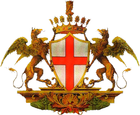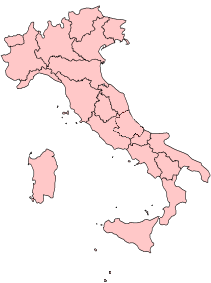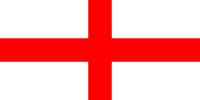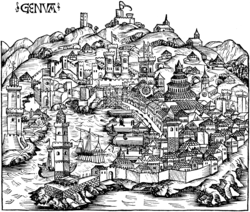Genoa
2007 Schools Wikipedia Selection. Related subjects: European Geography
| Comune di Genova | |
|---|---|
 Municipal coat of arms |
|
| Country | |
| Region | Liguria |
| Province | Genoa (GE) |
| Mayor | Giuseppe Pericu (since 2005- 05-30) |
| Elevation | 20 m |
| Area | 243 km² |
| Population | |
| - Total (as of 2006) | 620,316 |
| - Density | 2,553/km² |
| Time zone | CET, UTC+1 |
| Coordinates | |
| Gentilic | Genovesi |
| Dialing code | 010 |
| Postal code | 16100 |
| Frazioni | Acquasanta, Vesima |
| Patron | St. John the Baptist |
| - Day | June 24 |
|
|
|
| Website: www.comune.genova.it | |
Genoa ( Italian: Genova, Genoese: Zena) is a city and a seaport in northern Italy, the capital of the Province of Genoa and of the region of Liguria. The city has a population of ca. 620,000 and the urban area has a population of ca. 890,000.
Genua was a city of the ancient Ligurians. Its name is probably Ligurian, meaning "knee" (from Proto-Indo-European *genu 'knee'), i.e. "angle", from its geographical position, thus akin to the name of Geneva. Alternatively, the name has been claimed to derive from Latin Janua ("gate"), the two-headed god Janus, or an ancient word that means "foreigners", as the early settlers were considered foreign by the neighbouring population. Another definition which may be pertinent, is that the name 'Genoa' may be derived from Genua, founded by the two headed Giano, protector of ships and coins. This was a city of two faces, which looks both inland and towards the sea. Suffice to say that Genoa seems to be a locally and nationally accepted term, whereas Genova is more globally and internationally used. Unfortunately, the latter may lead to confusion with 'Geneva.'
Flag
The flag of Genoa is the St. George's flag, a red cross on a white field, exactly the same as that of England. It is possible that the flag of Genoa was adopted by England and the City of London in 1190 for their ships entering the Mediterranean to benefit from the protection of the powerful Genoese fleet. The maritime Republic of Genoa was rising and going to become, together with its rival Venice, one of the most important powers in the world. The English Monarch paid an annual tribute to the Doge of Genoa for this privilege. Between England and Genoa, two mercantile and sea-faring nations, there has always been a special, long-standing relationship. Genoa is generally regarded as "the most English town in Italy".
History
Ancient era and early Middle Ages
Genoa's history goes back to ancient times. The first historically known inhabitants of the area are the Ligures, an Italic tribe. The attribution of its foundation to Celts in 2500-2000 BC has been recently recognized as wrong.
A city cemetery, dating from the 6th and 5th centuries BC, testifies to the occupation of the site by the Greeks, but the fine harbour probably was in use much earlier, perhaps by the Etruscans. It is also probable that also Phoenicians had bases in Genoa, or in the nearby area, since an inscription with an alphabet similar to that used in Tyre has been found .
In the Roman era, Genoa was overshadowed by the powerful Marseille and Vada Sabatia, near modern Savona. Different from other Ligures and Celt settlements of the area, it was allied to Rome through a foedus aequum ("Equal pact") in the course of the Second Punic War. It was therefore destroyed by the Carthaginians in 209 BC. The town was rebuilt and, after the end of the Carthaginian Wars, received municipal rights. The original castrum thenceforth expanded towards the current areas of Santa Maria di Castello and the San Lorenzo promontory. Genoese trades included skins, wood, and honey. Goods were shipped in the mainland up to important cities like Tortona and Piacenza.
After the fall of the Roman Empire, Genoa was occupied by the Ostrogoths. After the Gothic War, the Byzantines made it the seat of their vicar. The Lombards submitted it in 643. In 773 the Lombard Kingdom was annexed by the Frank empire; the first Carolingian count of Genoa was Ademarus, who was given the title paraefectus civitatis Genuensis. Ademarus died in Corsica while fighting against the Saracens In this period the Roman walls, destroyed by the Lombards, were rebuilt and extended.
For the following several centuries, Genoa was little more than a small, obscure fishing centre, slowly building its merchant fleet which was to become the leading commercial carrier of the Mediterranean Sea. The town was sacked and burned in 934 by Arab pirates but it was quickly rebuilt.
In the 10th century the city, now part of the Marca Januensis ("Genoese Mark") was under the Obertenghi family, whose first member was Obertus I. Genoa was one of the first cities in Italy to have some citizenship rights granted by local feudataries.
Middle Ages & Renaissance
Before 1100, Genoa emerged as an independent city-state. Nominally, the Holy Roman Emperor was overlord and the Bishop of Genoa was president of the city; however, actual power was wielded by a number of "consuls" annually elected by popular assembly. Genoa was one of the so-called "Maritime Republics" ( Repubbliche Marinare), along with Venice, Pisa, and Amalfi) and trade, shipbuilding and banking helped support one of the largest and most powerful navies in the Mediterranean. The Republic of Genoa extended over modern Liguria and Piedmont, Sardinia, Corsica and had practically complete control of the Tyrrhenian Sea. Through Genoese participation on the Crusades, colonies were established in the Mideast, in the Aegean, in Sicily and Northern Africa. Genoese Crusaders brought home a green glass goblet from the Levant, which Genoese long regarded as the Holy Grail.
The collapse of the Crusader States was offset by Genoa’s alliance with the Byzantine Empire, which opened opportunities of expansion into the Black Sea and Crimea. Internal feuds between the powerful families, the Grimaldi, Doria, Spinola, and others caused much disruption, but in general the republic was run much as a business affair. Genoa's political zenith came with its victory over the Duchy of Pisa at the naval Battle of Meloria (1284), and its persistent rival, Venice, in 1298.
However, this prosperity did not last. The Black Death was imported into Europe in 1349 from the Genoese trading post at Caffa ( Theodosia) in Crimea, on the Black Sea. Following the economic and population collapse, Genoa adopted the Venetian model of government, and was presided over by a doge (see Doge of Genoa). The wars with Venice continued, and the War of Chioggia ( 1378- 1381), ended with a victory for Venice. After a period of French domination from 1394-1409, Genoa came under rule by the Visconti of Milan. Genoa lost Sardinia to Aragon, Corsica to internal revolt and its Middle Eastern colonies to the Ottoman Empire and the Arabs.
Christopher Columbus, a native of Genoa, donated one-tenth of his income from the discovery of the Americas for Spain to the Bank of San Giorgio in Genoa for the relief of taxation on foods. The Spanish connection was reinforced by Andrea Doria, who established a new constitution in 1528, making Genoa a satellite of the Spanish Empire. Under the ensuing economic recovery, many Genoese families amassed tremendous fortunes. At the time of Genoa’s peak in the 16th century, the city attracted many artists, including Rubens, Caravaggio and Van Dyck. The famed architect Galeazzo Alessi (1512-1572) designed many of the city’s splendid palazzi. A number of Genoese Baroque and Rococo artists settled elsewhere and a number of local artists became prominent.
Genoa suffered from French bombardment in 1684, and was occupied by Austria in 1746 during the War of the Austrian Succession. In 1768, Genoa was forced to cede Corsica to France.
Later history
With the shift in world economy and trade routes to the New World and away from the Mediterranean, Genoa's political and economic power went into steady decline.
In 1797, under pressure from Napoleon, Genoa became a French protectorate called the Ligurian Republic, which was annexed by France in 1805. Although the Genoese revolted against France in 1814 and liberated the city on their own, delegates at the Congress of Vienna sanctioned its incorporation into Piedmont ( Kingdom of Sardinia), thus ending the three century old struggle by the House of Savoy to acquire the city. The city soon gained a reputation as a hotbed of anti-Savoy republican agitation, although the union with Savoy was economically very beneficial. With the growth of the Risorgimento movement, the Genoese turned their struggles from Giuseppe Mazzini's vision of a local republic into a struggle for a unified Italy under a liberalized Savoy monarchy. In 1860, Giuseppe Garibaldi set out from Genoa with over a thousand volunteers to begin the campaign.This is called the departure of the thousands and a monument is set on the rock where the group departed from.
In World War II the British fleet bombarded Genova and one bomb fell into the cathedral of San Lorenzo without exploding and it is now available to public viewing in the Cathedral's crypt/museum.
Main sights
Genoa is one of the oldest cities of art in Italy. Its main features include the Piazza de Ferrari where the Opera and the Palace of the Doges are. There is also a house where Christopher Columbus is believed to have been born.
One part of the old city, the Strada Nuova or the Via Garibaldi, was inscribed on the World Heritage List in 2006. This district was designed in the mid-16th century to accommodate Mannerist palaces of the city's most eminent families, including Palazzo Rosso, Palazzo Bianco, Palazzo Grimaldi and Palazzo Reale. The famous art college, Musei di Strada Nuova and the Palazzo del Principe are also located on this street.
Other landmarks of the city include St. Lawrence Cathedral (Cattedrale di San Lorenzo), the Old Harbour (Porto Antico), transformed into a mall by architect Renzo Piano, and the famous cemetery of Staglieno, renowned for its monuments and statues. The Museo d'Arte Orientale has one of the largest collections of Oriental art in Europe.
Other than the old city sights, Genoa also has the second largest aquarium in the world which is located in the above-mentioned old harbour. The port of Genoa also contains an ancient lighthouse, called La Lanterna (i.e., "the lantern"). It is the oldest working lighthouse in the world, one of the five tallest ones, and the tallest brick one and it is Genoa's landmark.
Famous people
Famous Genoese include navigators Cristoforo Colombo and Andrea Doria, composers Niccolò Paganini and Michele Novaro, astronaut Franco Malerba, pope Benedict XV, painter Domenico Piola, Italian patriots Giuseppe Mazzini and Nino Bixio, writer and translator Fernanda Pivano, poet Edoardo Sanguineti, communist politician Palmiro Togliatti, architect Renzo Piano, Physics 2002 Nobel Prize winner Riccardo Giacconi, Literature 1975 Nobel Prize winner Eugenio Montale, artists Guido Galletti and Vanessa Beecroft, comedians Gilberto Govi, Paolo Villaggio, Beppe Grillo, Luca Bizzarri, Paolo Kessisoglu, Maurizio Crozza; folk singers Fabrizio de André and Ivano Fossati, actor Vittorio Gassman, and actress Moana Pozzi. Some reports say Giovanni Caboto is also from there.
Demographics
The population is homogeneously Italian. Southern and northern Italians alike have flocked to the city during the late 1900's. An estimated 95.3% of the population is of Italian origin. But there has been a sharp increase of immigrants mostly from South America, Eastern Europe, and a very meagre number from Asia.
Immigrants by country (2004)
- Ecuadorians - 10,169
- Albanians - 2,781
- Moroccans - 2,189
- Peruvians - 1,795
- Chinese - 910
- Romanians - 746
Sister cities
 Baltimore, Maryland, United States
Baltimore, Maryland, United States Columbus, Ohio, United States
Columbus, Ohio, United States Marseille, France
Marseille, France Chios, Greece
Chios, Greece Huelva, Spain
Huelva, Spain Odessa, Ukraine
Odessa, Ukraine Rijeka, Croatia
Rijeka, Croatia Guayaquil, Ecuador
Guayaquil, Ecuador














